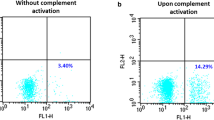Abstract
The cytotoxicity of human polymorphonuclear leukocytes (PMNs) against autologous red blood cells (RBC) and cultured vascular endothelial cells (EC) was investigated. PMNs were activated by phorbol myristate acetate (PMA) together with immune stimuli such as immune complexes and aggregated IgG. In the standard51Cr-release assay, in which PMA concentration was 5 ng/ml and effector versus target ratio was 5, 76.7% and 34.2% specific51Cr release was observed from RBC and EC, respectively. Significant levels of51Cr were released, albeit to a lesser degree, when PMNs were stimulated by immune stimuli. Further experiments which employed various scavengers of oxygen radicals suggested that hydrogen peroxide was the most potent mediator of this cytotoxicity; the implications of these in vitro observations with the pathogenesis of immune vasculitis are of clinical interest.
Similar content being viewed by others
References
Weissmann, G., andP. Dukor. 1973. The role of lysosomes in immune responses.Adv. Immunol. 12:283.
Henson, P. M. 1971. Release of biologically active constituents from blood cells and its role in antibody-mediated tissue injury.In Progress in Immunology. D. B. Amos, editor. Academic Press, New York. 155.
Barret, A. J. 1978. The possible role of neutrophil proteinases in damage to articular cartilage.Agents Actions 8:11.
Babior, B. M., R. S. Kipnes, andJ. T. Curnutte. 1973 Biological defense mechanisms: The production by leukocytes of superoxide, a potential bactericidal agent.J. Clin. Invest. 56:1035.
Klebanoff, S. J. 1975. Antimicrobial systems of the polymorphonuclear leukocyte.In The Phagocytic Cell in Host Resistance. J. A. Bellanti and D. H. Dayton, editors. Raven Press, New York. 45.
Kniker, W. T., andC. G. Cochrane. 1965. Pathogenetic factors in vascular lesions of experimental serum sickness.J. Exp. Med. 122:83.
Böyum, A. 1968. Isolation of mononuclear cells and granulocytes from human blood. Isolation of mononuclear cells by one centrifugation and of granulocytes by combining centrifugation and sedimentation at 1g.Scand. J. Clin. Lab. Invest. 21 (Suppl. 97):77.
Jaffe, E. A., R. L. Nachman, C. G. Becker, andC. R. Minick. 1973. Culture of human endothelial cells derived from umbilical veins.J. Clin. Invest. 52:2745.
Clark, R. A., andS. J. Klebanoff. 1979. Role of myeloperoxidase-H2O2-halide system in concanavalin A-induced tumor cell killing by human neutrophils.J. Immunol. 122:2605.
Weiss, S. J., andA. Slivka. 1982. Monocyte- and granulocyte-mediated tumor cell destruction. A role for the hydrogen peroxide-myeloperoxidase-chloride system.J. Clin. Invest. 69:255.
Slivka, A., A. F. LoBuglio, andS. J. Weiss. 1980. A potential role for hypochlorous acid in granulocyte-mediated rumor cell cytotoxicity.Blood 55:347.
Nathan, C. F., S. C. Silverstein, L. H. Brukner, andZ. A. Cohn. 1979. Extracellular cytolysis by activated macrophages and granulocytes. II. Hydrogen peroxide as a mediator of cytotoxicity.J. Exp. Med. 149:100.
Sachs, T., C. F. Moldow, P. R. Craddock, T. K. Bowers, andH. S. Jacob. 1978. Oxygen radicals mediate endothelial cell damage by complement-stimulated granulocytes.J. Clin. Invest. 61:1161.
Weiss, S. J., J. Young, A. F. LoBuglio, A. Slivka, andN. F. Nimeh, 1981. Role of hydrogen peroxide in neutrophil-mediated destruction of cultured endothelial cells.J. Clin. Invest. 68:714.
O'Flaherty, J. T., D. L. Kreutzer, andP. A. Ward. 1977. Neutrophil aggregation and swelling induced by chemotactic agents.J. Immunol. 119:232.
Hoover, R. L., R. T. Briggs, andM. J. Karnovsky. 1978. The adhesive interaction between polymorphonuclear leukocytes and endothelial ceils in vitro.Cell 14:423.
Till, G. O., K. J. Johnson, R. Kunkel, andP. A. Ward 1982. Intravascular activation of complement and acute lung injury. Dependency on neutrophils and toxic oxygen metabolites.J. Clin. Invest. 69:1126.
Hashimoto, Y., andE. R. Hurd. 1981. Human neutrophil aggregation and increased adherence to human endothelial cells induced by heat-aggregated IgG and immune complexes.Clin. Exp. Immunol. 44:538.
Hurd, E. R., andY. Hashimoto. 1981. Human neutrophil swelling induced by immune complexes and aggregated immunoglobulins.Inflammation 5:213.
Hashimoto, Y., M. Ziff, andE. R. Hurd 1981. Increased endothelial cell adherence, aggregation, and superoxide generation by neutrophils incubated in systemic lupus erythematosus and Felly's syndrome sera.Arthritis Rheum. 25:1409.
Author information
Authors and Affiliations
Additional information
Supported by Manabe Medical Foundation.
Rights and permissions
About this article
Cite this article
Hashimoto, Y., Tanimoto, K., Yoshinoya, S. et al. Destruction of cultured vascular endothelial cells and red blood cells by immune-activated polymorphonuclear leukocytes. Inflammation 11, 201–210 (1987). https://doi.org/10.1007/BF00916021
Issue Date:
DOI: https://doi.org/10.1007/BF00916021




